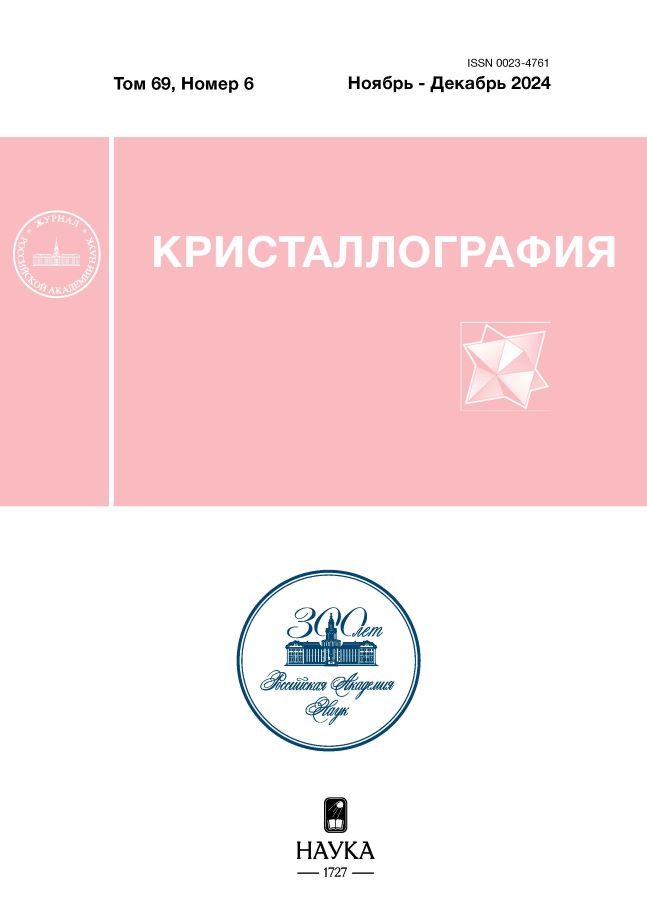Peculiarities of formation of defects initiating fatigue faults in granular alloy EP741NP
- Authors: Pavlov I.S.1, Artamonov M.A.2, Artemov V.V.1, Kumskov A.S.1, Marchukov E.Y.2, Vasiliev A.L.1,3
-
Affiliations:
- Shubnikov Institute of Crystallography of Kurchatov Complex of Crystallography and Photonics of NRC National Research Centre “Kurchatov Institute”
- Lyulka Design Bureau
- Moscow Institute of Physics and Technology (National Research University) Moscow region
- Issue: Vol 69, No 6 (2024)
- Pages: 927-937
- Section: REAL STRUCTURE OF CRYSTALS
- URL: https://ruspoj.com/0023-4761/article/view/673607
- DOI: https://doi.org/10.31857/S0023476124060027
- EDN: https://elibrary.ru/YILVYE
- ID: 673607
Cite item
Abstract
The samples of EP741NP alloy destroyed during fatigue testing were investigated by means of transmission electron microscopy, energy-dispersive X-ray microanalysis and electron diffraction. The composition and crystal structure of defects detected at the boundaries of fatigue cracks were studied in details. It was shown that such defects mainly have the morphology of elongated flat "carpets" containing NiO, CTixNb1–x, amorphous AlOx, HfO2, Al2O3, β-Al2O3, Al2MgO4, Co7Mo6, Co3O4, S4Ti3, NbO2, TiO2, as well as amorphous regions containing C, O, Ca, S, Na and Cl. Assumptions were made about the source and of time formation of the studied defects.
Full Text
About the authors
I. S. Pavlov
Shubnikov Institute of Crystallography of Kurchatov Complex of Crystallography and Photonics of NRC National Research Centre “Kurchatov Institute”
Author for correspondence.
Email: a.vasiliev56@gmail.com
Russian Federation, Moscow
M. A. Artamonov
Lyulka Design Bureau
Email: a.vasiliev56@gmail.com
Russian Federation, Moscow
V. V. Artemov
Shubnikov Institute of Crystallography of Kurchatov Complex of Crystallography and Photonics of NRC National Research Centre “Kurchatov Institute”
Email: a.vasiliev56@gmail.com
Russian Federation, Moscow
A. S. Kumskov
Shubnikov Institute of Crystallography of Kurchatov Complex of Crystallography and Photonics of NRC National Research Centre “Kurchatov Institute”
Email: a.vasiliev56@gmail.com
Russian Federation, Moscow
E. Yu. Marchukov
Lyulka Design Bureau
Email: a.vasiliev56@gmail.com
Russian Federation, Moscow
A. L. Vasiliev
Shubnikov Institute of Crystallography of Kurchatov Complex of Crystallography and Photonics of NRC National Research Centre “Kurchatov Institute”; Moscow Institute of Physics and Technology (National Research University) Moscow region
Email: a.vasiliev56@gmail.com
Russian Federation, Moscow; Dolgoprudny
References
- Williams J.C., Starke E.A. // Acta Mater. 2003. V. 51. P. 5775. https://doi.org/10.1016/j.actamat.2003.08.023
- Caron P., Khan T. // Aerosp. Sci. Technol. 1999. V. 3. P. 513. https://doi.org/10.1016/S1270-9638(99)00108-X
- Sato A., Chiu Y.-L., Reed R.C. // Acta Mater. 2011. V. 59. P. 225. https://doi.org/10.1016/j.actamat.2010.09.027
- Xia W. et al. // J. Mater. Sci. Technol. 2020. V. 44. P. 76. https://doi.org/10.1016/j.jmst.2020.01.026
- Gayda J., Gabb T.P., Kantzos P.T. // Superalloys. 2004. P. 323.
- Волков А.М. et al. // Технология металлов. 2019. № 1. С. 2. https://doi.org/10.31044/1684-2499-2019-1-0-2-8
- Гарибов Г.С., Кошелев В.Я., Шорошев Ю.Г. и др. // Заготовительные производства в машиностроении. 2010. № 1. С. 45.
- Belan J. // Mater. Today Proc. 2016. V. 3. P. 936. https://doi.org/10.1016/j.matpr.2016.03.024
- Ida S. et al. // Metals (Basel). 2022. V. 12. P. 1817. https://doi.org/10.3390/met12111817
- Zhao S. et al. // Mater. Sci. Eng. A. 2003.V. 355. P. 96. https://doi.org/10.1016/S0921-5093(03)00051-0
- Трунькин И.Н. и др. // Кристаллография. 2019. Т. 64. С. 539. https://doi.org/10.1134/S002347611904026X
- Симс Ч.Т., Норман С.С., Уильям С.Х. Суперсплавы II. Жаропрочные материалы для аэрокосмических и промышленных энергоустановок. Т. 1. М.: Металлургия, 1995. 384 с.
- Pavlov I.S. et al. // Scr. Mater. 2023. V. 222. P. 115023. https://doi.org/10.1016/j.scriptamat.2022.115023
- Myasoedov A.V. et al. // J. Appl. Phys. 2024. V. 135. https://doi.org/10.1063/5.0189133
- Ievlev V.M. et al. // Inorg. Mater. 2023. V. 59. P. 1295. https://doi.org/10.1134/S002016852312004X
- Кишкин С.Т., Качанов Е.Б., Булыгин И.П. Авиационные материалы. Т. 3. Жаропрочные стали и сплавы. Сплавы на основе тугоплавких металлов. М.: ВИАМ, 1989. 566 с.
- ГОСТ Р 52802-2007 Сплавы никелевые жаропрочные гранулируемые. Марки.
- Peng Y. et al. // Calphad. 2020. V. 70. P. 101769. https://doi.org/10.1016/j.calphad.2020.101769
- Gutiérrez G., Johansson B. // Phys. Rev. B. 2002. V. 65 P. 104202. https://doi.org/10.1103/PhysRevB.65.104202
- Beevers C.A., Ross Μ.A.S. // Z. Kristallogr. Cryst. Mater. 1937. V. 97. P. 59. https://doi.org/10.1524/zkri.1937.97.1.59
- Kato K., Saalfeld H. // Acta Cryst. B. 1977. V. 33. P. 1596. https://doi.org/10.1107/S0567740877006608
- Bettman M., Peters C.R. // J. Phys. Chem. 1969. V. 73. P. 1774. https://doi.org/10.1021/j100726a024
- Bettman M., Terner L.L. // Inorg. Chem. 1971. V. 10. P. 1442. https://doi.org/10.1021/ic50101a025
- Sasaki S., Fujino K., Takéuchi Y. // Proc. Jpn Acad. Ser. B. 1979. V. 55. P. 43. https://doi.org/10.2183/pjab.55.43
- Prostakova V. et al. // Calphad. 2012. V. 37. P. 1. https://doi.org/10.1016/j.calphad.2011.12.009
- Johnson B., Jones J.L. Ferroelectricity in Doped Hafnium Oxide: Materials, Properties and Devices. Elsevier, 2019. 570 p. https://doi.org/10.1016/B978-0-08-102430-0.00002-4
- R Taylor J. et al. // Calphad. 1992. V. 16. P. 173. https://doi.org/10.1016/0364-5916(92)90005-I
- Alper A.M. et al. // J. Am.Ceram. Soc. 1962. V. 45. P. 263. https://doi.org/10.1111/j.1151-2916.1962.tb11141.x
- Davydov A., Kattner U.R. // J. Phase Equilibria. 1999. V. 20. P. 5. https://doi.org/10.1361/105497199770335893
- Chen M., Hallstedt B., Gauckler L.J. // J. Phase Equilibria. 2003. V. 24. P. 212. https://doi.org/10.1361/105497103770330514
- Murray J.L. // Bull. Alloy Phase Diagrams. 1986. V. 7. P. 156. https://doi.org/10.1007/BF02881555
- Pérez R.J., Massih A.R. // J. Nucl. Mater. 2007. V. 360. P. 242. https://doi.org/10.1016/j.jnucmat.2006.10.008
- Okamoto H. // J. Phase Equilibria Diffus. 2011. V. 32. P. 473. https://doi.org/10.1007/s11669-011-9935-5
Supplementary files


















